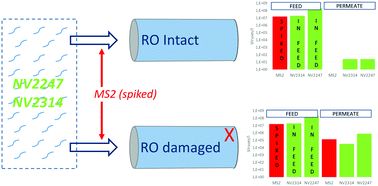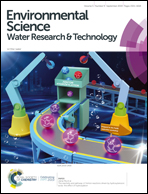Monitoring the integrity of reverse osmosis membranes using novel indigenous freshwater viruses and bacteriophages
Abstract
High pressure membranes are increasingly used for the treatment of contaminated water for various purposes including irrigation and drinking water. The lack of a fast and easy to implement membrane integrity test method with a log removal value (LRV) >3 hampers the implementation of these membranes. Current on-line methods include conductivity, TOC (total organic carbon) and turbidity measurements and can monitor a maximum LRV of 3. Furthermore, challenge tests using chemical or bacteriological virus surrogates such as bacteriophage MS2 show that RO and NF systems can reach LRVs of 6–7, but dosing of these surrogates is not feasible and desirable in full scale drinking water plants. This study describes the identification and use of indigenous viruses, naturally present in surface waters to monitor the integrity of RO membranes in a pilot installation. Natural viruses were identified from fresh source water using metagenomics and qPCR primers developed for a selected set of viruses that were present in high numbers in surface water. The qPCR assays were used to determine the number of gene copies of these viruses in the feed and permeate of the pilot RO installation, and the LRV of these natural viruses was compared with the LRV of spiked MS2 and with on-line conductivity. The concentration of the selected natural viruses in the source water was sufficient to demonstrate a LRV of >7 and was comparable to the results of the spiked MS2 bacteriophage. Furthermore, after inflicting damage to the membrane element by drilling small holes of 1 and 4 mm, both MS2 and the natural viruses detected the damage to the membrane with a nearly identical decrease of LRV, while conductivity lacked sensitivity to monitor any integrity loss. This novel method enables monitoring of the RO membrane integrity at a high sensitivity (LRV > 7), without the addition of chemical or biological virus surrogates. Furthermore, the high concentration of viruses in source water simplifies detection without laborious sample concentration procedures. The implementation of this method facilitates monitoring of the integrity of RO membranes in full scale operation with a much higher sensitivity than current methods.



 Please wait while we load your content...
Please wait while we load your content...